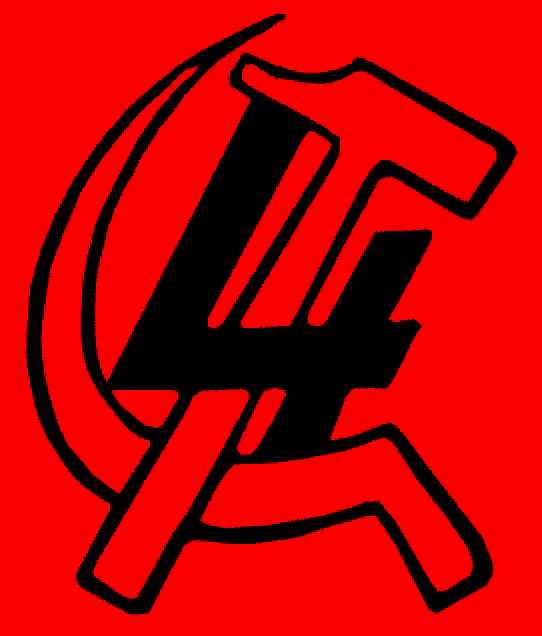
August 2008
Haitian Workers in the Dominican Republic
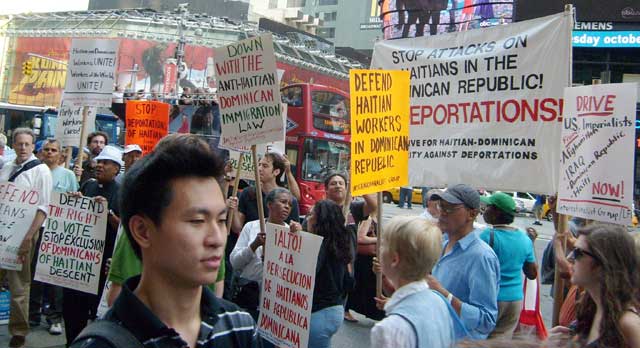
Demonstrators outside Dominican consulate in Times Square, New York, August 7 call for full rights
for Haitians residing in the Dominican Republic. (Internationalist photo)
On
August 7, an emergency picket was held in
New York City against the threat of mass
deportations of Haitian workers from the
Dominican Republic. More than 75 people
participated in the
demonstration, which was organized by a
united-front Initiative for
Haitian-Dominican Solidarity Against
Deportations. This was the first time in
recent years that groups representing
immigrants from both sides of the Caribbean
island of Hispaniola (or Quisqueya, as it
was called by the indigenous Taíno people) have joined
together in protest against the racist
treatment of Haitians in the Dominican
Republic. That point was not lost on the
Dominican government. The protest was given
prominent coverage in the Santo Domingo
daily Diario Libre and in El
Nuevo Diario of San Juan (Puerto
Rico), highlighting the presence of Pulitzer
Prize-winning author Junot Díaz at
the protest.
For
decades, the Dominican ruling class has
extracted superprofits from the near-slave
labor of Haitian workers. Laborers are
rounded up in Haiti, trucked into the
Dominican sugar estates to perform the
backbreaking work of cutting sugar cane,
paid starvation wages and kept locked up in
bateys (shantytowns on the edge of
the fields). Then after viciously exploiting
them, the Dominican bosses call in the
military to dump them back across the
border. Periodically right-wing Dominican
politicians whip up anti-Haitian hysteria to
stage racist pogroms against the
long-established Haitian community. At
present this includes up to one million
Haitian immigrants and Dominicans of Haitian
descent, constituting about 15 percent of
the entire population of the Dominican
Republic.
The
1937 massacre of Haitians and dark-skinned
Dominicans by the
U.S.-installed dictator Rafael Leonidas
Trujillo is internationally infamous. Not so
well known is the fact that this “ethnic
cleansing” was sanctioned by the United
States government, and even by its puppet
regime in Haiti. The current president of
the Dominican Republic, Leonel
Fernández, who grew up in New York
City, was elected to his first term in 1996
in a campaign that used
vicious racist prejudice against his main
opponent, José Francisco Peña
Gómez, because of the latter’s
Haitian ancestry. In 2005, during
Fernández’ second term, politicians
in the ruling coalition instigated a climate
of racist hysteria in which dozens of
Haitians were slaughtered, hacked to death
by machetes or burned alive after being
doused with gasoline. Many others were
rounded up and deported.
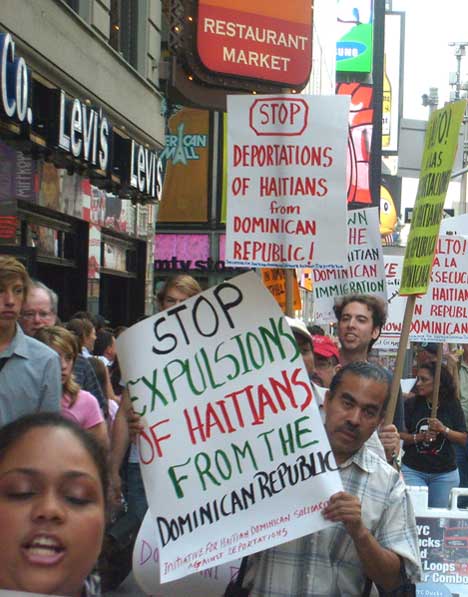 An estimated
60,000 Haitians and scores of Dominicans of
Haitian descent were expelled from the
Dominican Republic in 2005. Since that time,
monthly pickets have been held outside the
Dominican Consulate in New York City,
initiated by the group Grassroots Haiti. The
Internationalist Group has regularly
participated in these protests, which,
although small, have been covered in the
Dominican press and thus help to keep the
pressure on. But when the Dominican director
of immigration was quoted in the press this
June 31 saying that Haitian immigration had
become “unbearable,” that recent immigrants
should “return to Haiti” and that
Fernández should make this a priority
in his third term, which began August 16, we
decided to approach Dominican and Haitian
organizations to hold an emergency protest
in early August.
An estimated
60,000 Haitians and scores of Dominicans of
Haitian descent were expelled from the
Dominican Republic in 2005. Since that time,
monthly pickets have been held outside the
Dominican Consulate in New York City,
initiated by the group Grassroots Haiti. The
Internationalist Group has regularly
participated in these protests, which,
although small, have been covered in the
Dominican press and thus help to keep the
pressure on. But when the Dominican director
of immigration was quoted in the press this
June 31 saying that Haitian immigration had
become “unbearable,” that recent immigrants
should “return to Haiti” and that
Fernández should make this a priority
in his third term, which began August 16, we
decided to approach Dominican and Haitian
organizations to hold an emergency protest
in early August.
The response was
positive, and weekly planning meetings were
held during July. It was established that
this would be a united-front action, around
four demands: Stop the expulsions of
Haitians from the Dominican Republic; defend
Haitians in the Dominican Republic against
violence and persecution; down with the
anti-Haitian Dominican immigration law; and
defend the right to vote – down with
attempts to disenfranchise Dominicans of
Haitian origin! There was also agreement
that both in the U.S. and the Dominican
Republic, everyone should have equal rights.
Beyond that, each participating organization
was free to present its own program. A
leaflet for the picket was issued in
English, Spanish and Kreyol; a fact sheet
detailing the persecution of Haitians in the
Dominican Republic was prepared; a press
release was sent out, and a letter written
to Dominican president Fernández to
be presented to the consulate.
As a
result of this work, more than a dozen
Dominican and Haitian organizations and
personalities joined in calling for the
picket. The main groups involved in
preparing the protest were Grassroots Haiti,
Fuerza de la Revolución (Dominican
Republic), the Internationalist Group and
the League for the Revolutionary Party.
Father Luis Barrios of Iglesia San Romero
and Pastors for Peace endorsed while Sonia
Pierre, leader of the Movement of
Dominican-Haitian Women, sent a message of
support. Articles appeared in the New York
Spanish-language daily El Diario-La
Prensa, as well as interviews and
spots on Haitian community radio and TV. On
the day of the protest, NY 1 Noticias
broadcast a story on the press conference
prior to meeting with the Dominican
vice-consult to deliver the letter to
President Fernández.
The
picket was well-attended and spirited, with
chanting and speeches lasting for a full two
hours, from 5 to 7 p.m. Demonstrators
chanted, “Dominican government, hands off
Haitian workers,” “Stop the racist
deportations,” “Haitian and Dominican
workers unite,” “Haitianos y dominicanos,
unidos en la lucha,” “La lucha
obrera no tiene frontera” and
“Dominican repression, made in U.S.A.” In
addition to the picketers, quite a number of
passers-by stopped to listen to the speakers
from the groups participating. Several noted
that in New York City, where up to a million
Dominican and Haitian residents feel the
weight of anti-immigrant repression, it is
possible to overcome the nationalist
animosity fanned by reactionary bourgeois
politicians. The IG emphasized the
importance of struggle for socialist
revolution on both sides of the island of
Quisqueya, and extending to the U.S. as
well.
Excerpts from some of the speeches
at the August 7 picket of the Dominican
consulate:
Jan Norden
(Internationalist Group): It’s
significant
that today, for the first time in some time,
we have a united protest by Haitian,
Dominican and North American organizations.
This is a united front, there are many
different viewpoints here. We are united in
saying that people who are here in the
United States should have equal rights with
everyone else, and also in the Dominican
Republic.
People
should
understand that the repression in the
Dominican Republic is made in U.S.A. The
repression against the Haitian population in
Haiti is a direct result of the “war on
terror” against Afghanistan, against Iraq,
against the working people of Colombia,
throughout Latin America. The system of
slave labor that is functioning in the
Dominican Republic was set up by the United
States when it occupied both Haiti and the
Dominican Republic in the early part of the
20th century. The armies of both Haiti and
the Dominican Republic were set up by the
United States. In the massacre of 1937,
almost 40,000 Haitians were murdered by the
dictator Rafael Trujillo, a former officer
in the U.S. colonial army. And today, 40
trainers of the Southern Command of the U.S.
Army are in the Dominican Republic where
they are training the Dominican army in
repression on the border, preparing for mass
expulsions.
We
need to mobilize the power of the working
class, not only in defense of the Haitian
workers in the Dominican Republic but also
against our own bourgeoisie, our own ruling
class and against the war that they are
waging in the Near East and everywhere. This
past May 1st, the dock workers shut down
every port on the West Coast against the
war. This is the first time in the history
of the United States that there has been a
political strike against a U.S. war. We need
to generalize that, and also to give it
political consciousness, because the union
bureaucracy that first tried to stop this
strike, then tried to wrap it in the Stars
and Stripes.
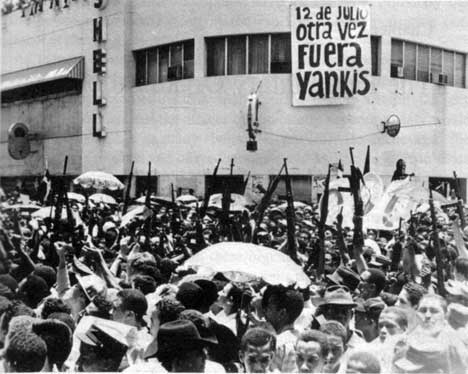 April 1965 uprising in Santo
Domingo against U.S. imperialist invasion
of Dominican Republic.
April 1965 uprising in Santo
Domingo against U.S. imperialist invasion
of Dominican Republic.
In
1965 there was a U.S. invasion of the
Dominican Republic. This came when the U.S.
was mounting its blockade against Cuba. At
that time, we fought, as we fight today, to
defend the Cuban Revolution against
counterrevolution, from within and without,
and to extend it. In 1965, when the United
States invaded Santo Domingo, they did so in
order to strike at Cuba. The United States
government gave as the excuse to invade
Santo Domingo – like under McCarthyism –
that “we have a list of 58 communists in the
Dominican Republic who are involved in the
revolt.” At the
university that I was attending then, when
someone mentioned this point, that there
were supposedly 58 communists, we chanted,
“58 communists is not enough!”
We
need revolutionary struggle, for
international socialist revolution, because
it’s not going to be made in the Dominican
Republic alone, it’s not going to be made in
Haiti alone – if there’s going to be a
revolution in the Caribbean, it’s going to
be on both sides of that border. And we need
to extend that revolution to the heartland,
to the belly of the imperialist beast, which
is right here, in the United States.
Father Barrios: A journalist was
asking me, “you’re not Dominican, you’re not
Haitian, what the hell are you doing here?”
People, this is about human rights. This is
our responsibility. We have a responsibility
to build a better society, a better world.
There is a name to describe what is going on
in the Dominican Republic against the
Haitian community. It’s not just against
Haitians, it’s also against Dominicans of
Haitian descent. The name is racism, the
name is xenophobia. So let’s start calling
things by their right name. We’re not going
anywhere until we see peace with justice for
all these people.
Mario Pierre
(Grassroots Haiti): In the Dominican
Republic today, Haitian workers are being
used as slaves. There is slave labor going
on right on the border of Haiti and the
Dominican Republic. For years, Haitian
workers were being contracted to go to the
Dominican Republic to cut sugar cane. As the
Dominican economy expanded, Haitian workers
were used in different sectors in the
Dominican economy, such as construction,
agriculture, domestic work and various other
sectors. Haitian workers today are no longer
being contracted, but they are being
recruited in Haiti to fill the labor pools
in the Dominican Republic. When the Haitian
workers get there, they cannot leave. They
cannot get out of the bateys in the
Dominican Republic, if they do, they will
get killed.
However,
because
the bourgeoisie in the Dominican Republic is
exploiting them, they’re making all the
profits, they’re not giving them any
benefits. A lot of people today are blaming
Haitian workers. After they exploit them to
their very last drop of blood, they just
pick them up and deport them to Haiti. That
is an injustice, and we are here to protest
against this injustice.
Abram Negrete
(Internationalist Group): The deportations
of Haitian workers from the Dominican
Republic are intimately connected with the
racist deportations from the United States
of Dominican workers, of Haitian workers, of
African workers, of Asian workers, of
Mexican workers. When we say “la lucha
obrera no tiene frontera,” when we say
“the workers’ struggle has no border,” it
means that we fight against these racist
deportations here in the United States, in
the Dominican Republic and everywhere,
because we fight for full citizenship rights
for all immigrants.
Two
semesters ago I had the privilege of
teaching a class on Dominican heritage,
where we talked about how the division of
the island of Hispaniola between the
Dominican Republic and Haiti was the product
of two interrelated things, of empire, and
of slavery. We learned about how slavery was
overthrown through a social revolution, the
Haitian Revolution led by Toussaint
Louverture, which was the only way to
destroy slavery – a revolution of the slaves
against the slave owners.
That is what we need today, a
revolution of the working class, a
revolution of the slaves of capital, in the
Dominican Republic, in Haiti, in the United
States and throughout the world.
The
Dominican workers have a proud and glorious
history of struggle against imperialist
intervention. We will never forget the
heroic fight of the Dominican workers, who
drove back the filthy American Marine
intervention [in 1965] under the Democrat
Lyndon Johnson, the murderer of Vietnam; who
drove them back, only to be sold out by the
reformist and Stalinist leadership. We need
to unite the tradition of revolutionary
struggle of the Haitian proletariat, of the
Dominican proletariat, and the international
working class for an international
proletarian revolution.
Translated
from Diario
Libre, 8 August 2008
Junot Díaz Participated in
Pro-Haitian Picket in Front of New York
Consulate
By MIGUEL CRUZ TEJADA
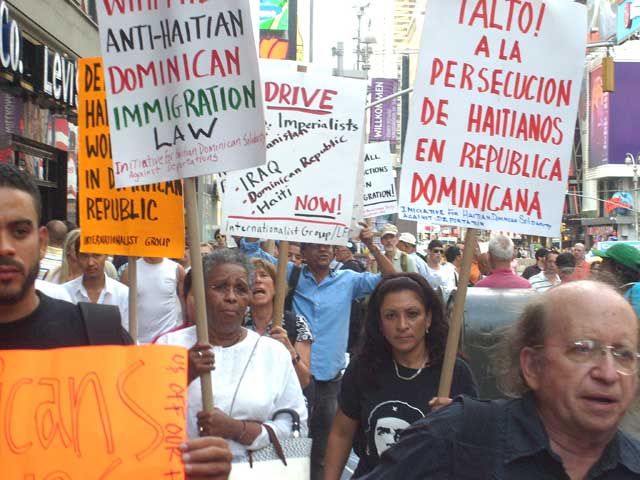
NEW YORK – A
well-attended picket held yesterday in front
of the building holding the Dominican consular
offices at 1501 Broadway in Times Square
denounced the “cruel and inhuman” treatment by
the government of the Dominican Republic of
Haitian immigrants who live and/or work in the
other half of the Caribbean island.
The
demonstration, part of a series of protests
scheduled this year in the same location, was
the most numerous of those held so far and
included prominent figures from the community
and internationally including the writer Junot
Díaz, winner of this year’s Pulitzer
Prize, the exile Víctor Toro, a founder
of the Chilean MIR (Movement of the
Revolutionary Left) and Episcopal priest Luis
Barrios, member of “Pastors for Peace” and a
champion of international solidarity.
Well-known Dominican, Haitian and
Haitian-Dominican community, political and
cultural activists also participated in the
demonstration. Among them was Radhamés
Pérez, founder and leader of the
Revolutionary Movement New Fatherland.
The
picket was organized by the Initiative for
Haitian-Dominican Solidarity and more than a
dozen other local and international
organizations. “La lucha obrera no tiene
frontera” (workers’ struggle has no
borders) was one of the slogans heard echoing
of the attractive lit-up walls of the most
important tourist center of New York.
The
protest began at 5:00 in the afternoon and
concluded a little after 7:00 in the evening.
Passers-by from around the world who went by
the protesters stopped to read the large signs
in which the sponsoring groups denounced the
“cruelty” and “inhumanity” of the immigration
policies of the government of Leonel
Fernández against immigration by its
closest neighbors.
“Stop
the deportations and repression against
Haitian workers now,” read various signs. A
giant banner was displayed in the center of
the protest.
Various
of the best-known activists, including the
Haitian Mario Pierre and Father Barrios, spoke
to the crowd with brief speeches denouncing
the cruel repression against the Haitians
residing in the Dominican Republic and the
denial of Dominican citizenship to the
children of the latter who were born on this
side of the island....
The
prominent writer Junot Díaz said that
he was participating in the action in response
to an invitation from the organizers and in
solidarity with Haitians who were victims of
the situation of mistreatment in the Dominican
Republic.
“As
someone who travels to Santo Domingo about
four or five times a year, and who still lives
in a popular barrio of the capital, Villa
Juana, what I see is how people there mistreat
the Haitians. The anti-Haitian language that I
hear from ordinary people, for example in my
neighborhood, is a very ugly business and we
have to do something to try to change the
situation,” said the award-winning Dominican
writer.
“Anyone
who tells me that Dominicans are[n’t] anti-Haitian is
crazy. I was born in Santo Domingo and the
hatred you have there against Haitians is
really impressive. It sometime makes you laugh
to hear a Dominican who is blacker than three
Haitians saying that these immigrants are
bad,” the writer added.
“It’s a
madness and a sickness that we have to cure,”
said the author of The Brief Wondrous Life
of Oscar Wao. Asked if he had in mind to
work on a piece on the situation of Haitians,
he said that his participation had nothing to
do with his career as a writer and professor.
“In all
my writings I always touch on this issue
because where I come front, on Calle 21 in
Villa Juana, I come across this drama every
day,” he explained. “You see it. You have to
do something about it in order to improve as a
human being, not to keep rising as an artist.”
Father
Barrios, a Puerto Rican, said that he was
supporting the Haitians because he had worked
with them and with the Dominicans on both
sides of the divided island. “My presence here
is part of my position of international
solidarity with the downtrodden of the world,
wherever they may be,” the pastor added.
Jorge
Alvarado, coordinator of Nueva Alternativa
(New Alternative) in New York, said that his
organization joined with the Haitians in this
struggle pressuring the government to halt its
cruel and inhuman policy toward them.
When
this reporter reminded him that Dominicans who
support the struggle of the Haitians are
accused of being “traitors,” he responded that
“there are always people who are not aware.”
–Would
you be in favor of unifying the island?
–Of
course! Haitians are being subjected to
terrible injustices and this has got to stop.
When it
was objected that this “unification” is
impossible because of differences of religion,
culture, race and language, the leftist leader
responded: “As the burro goes along its path,
people are always comparing its burden.”
To contact the Internationalist Group and the League for the Fourth International, send e-mail to: internationalistgroup@msn.com